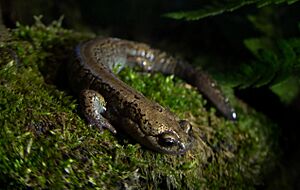Siberian salamander facts for kids
Quick facts for kids Siberian salamander |
|
|---|---|
 |
|
| Conservation status | |
| Scientific classification | |
| Genus: |
Salamandrella
|
| Species: |
keyserlingii
|
| Synonyms | |
|
|
The Siberian salamander, also known as Salamandrella keyserlingii, is a special type of salamander. You can find these amazing creatures in Northeast Asia. They love living in wet woods and areas near rivers, which are called riparian groves.
Contents
Where the Siberian Salamander Lives
The Siberian salamander lives across a huge area! Most of them are found in Siberia, a vast region in Russia. They live east of the Urals mountains and spread across the East Siberian Mountains.
You can also find them in places like the Kamchatka Peninsula and south into Manchuria. Some groups also live in northern Kazakhstan, Mongolia, northeastern China, and on the Korean Peninsula. Sadly, they are no longer found in South Korea.
There's even a small group of these salamanders living far away in Hokkaidō, Japan. They make their home in the Kushiro Shitsugen National Park. A special place in North Korea, called Paegam, is a protected breeding ground for them. It's even called North Korean natural monument #360!
What Does a Siberian Salamander Look Like?
Adult Siberian salamanders are usually about 9 to 12.5 centimeters long. That's about the length of a small pencil! Their bodies are a bluish-brown color. They often have a cool purple stripe running down their back.
You might also see thin, dark brown stripes near their eyes or sometimes on their tail. Each of their feet has four toes, but they don't have claws. Their tail is usually longer than their body. Fun fact: male salamanders are typically a bit smaller than the females.
How Siberian Salamanders Survive the Cold
These salamanders are super tough! They are famous for being able to survive in extremely cold temperatures, even as low as -45 degrees Celsius. That's colder than most freezers!
Sometimes, they can even stay frozen solid in permafrost (ground that's always frozen) for years. When the ice melts, they can actually thaw out and just walk away! They do this by losing a lot of water from their bodies and shrinking their liver. They also make more glycerol, a type of sugar alcohol, in their bodies. This acts like a natural antifreeze, protecting their cells from freezing damage.
Siberian Salamander Behavior
The Siberian salamander is mostly active at night. This means they are nocturnal. They come out to look for food when it's dark. During the day, they like to hide under moist logs or other woody bits on the ground to stay safe and cool.
Siberian Salamander Habitat
These salamanders live in many different types of wet places across their wide range. They can be found in wet forests with conifer trees or mixed forests with both conifer and deciduous trees. They also live in wet areas near rivers in the tundra and grasslands.
You might spot them near temporary or permanent pools of water, in wetlands, or in grassy areas near old river bends. They really like places that are damp and have plenty of water nearby.
Siberian Salamander Life Cycle and Reproduction
Siberian salamanders usually lay their eggs in May or early June. They choose pools of water for their breeding season. A female salamander typically lays between 50 to 80 eggs in one egg sac. In total, she might lay up to 240 eggs in a single season!
The eggs are light brown and usually hatch about three to four weeks after they are laid. When the baby salamanders hatch, they are called larvae. They are very tiny, only about 11 to 12 millimeters long!
Images for kids




